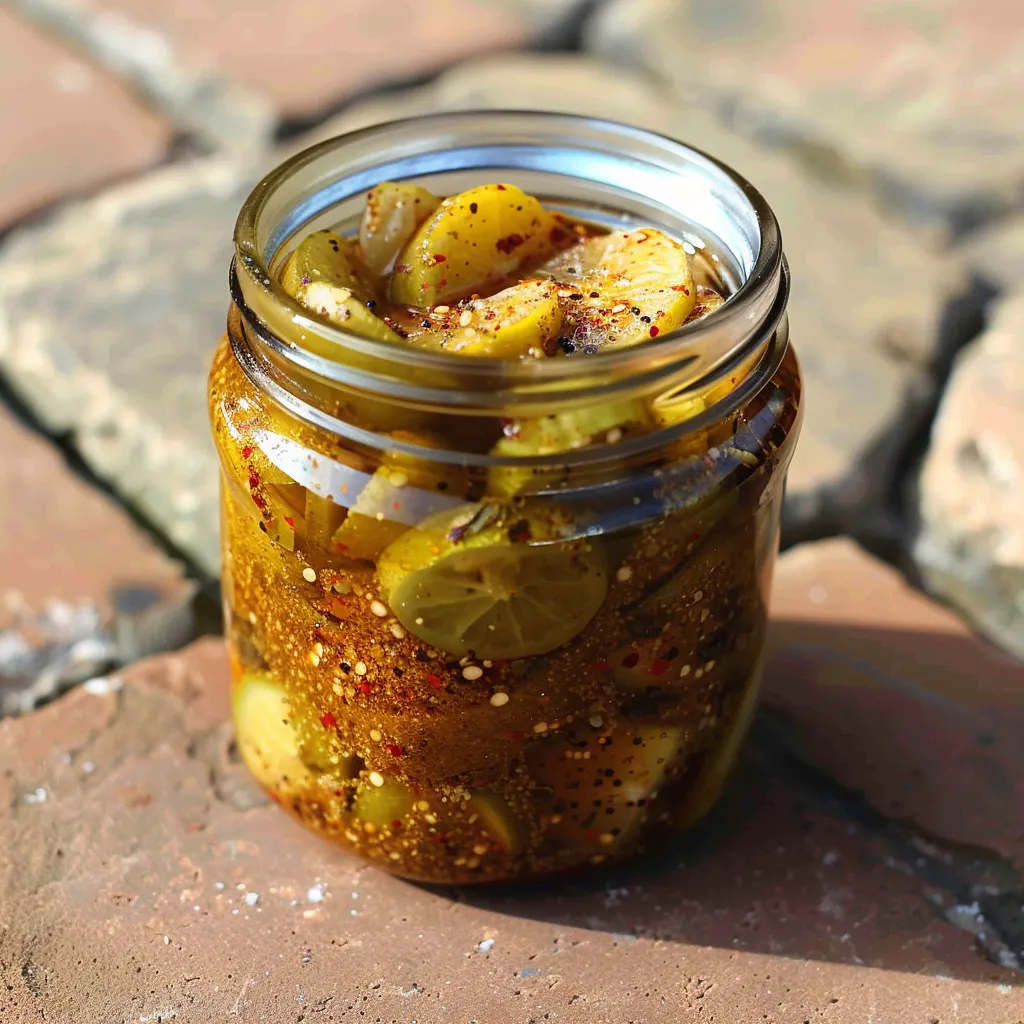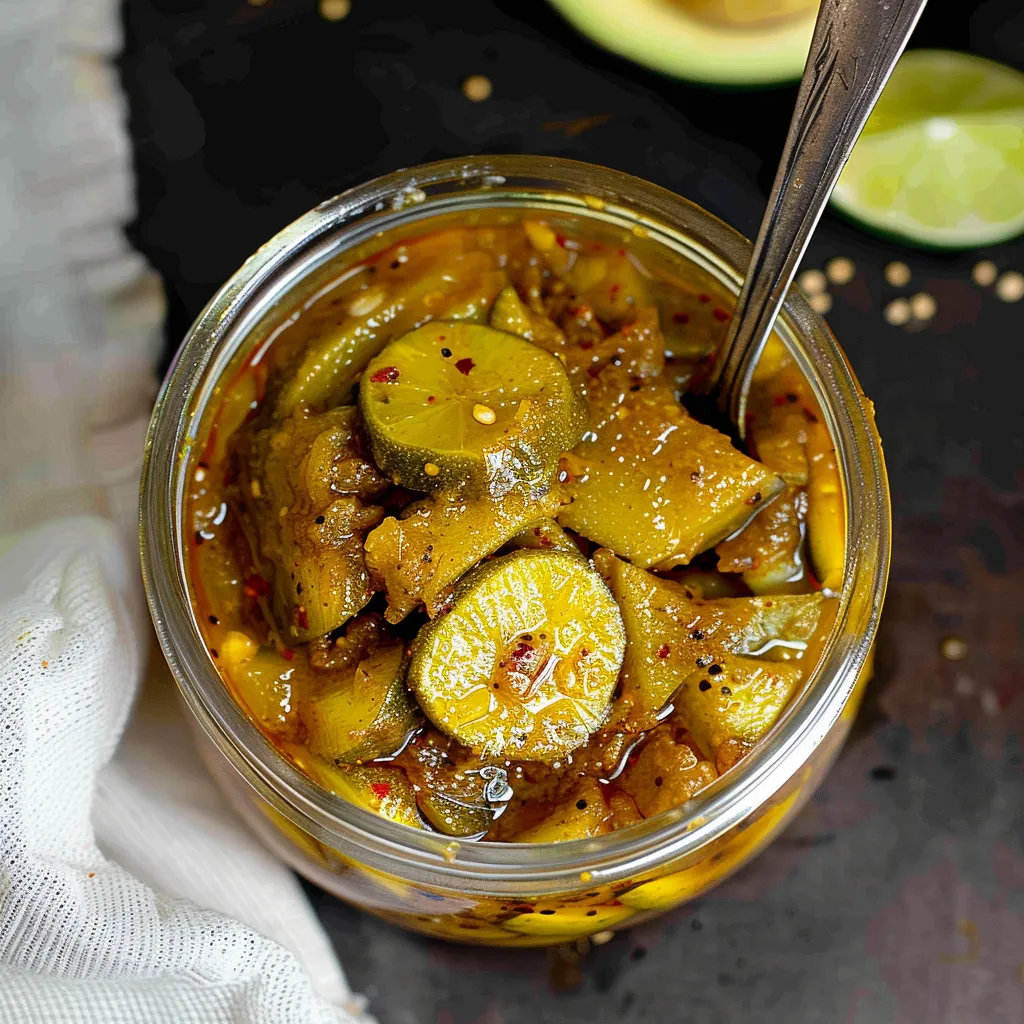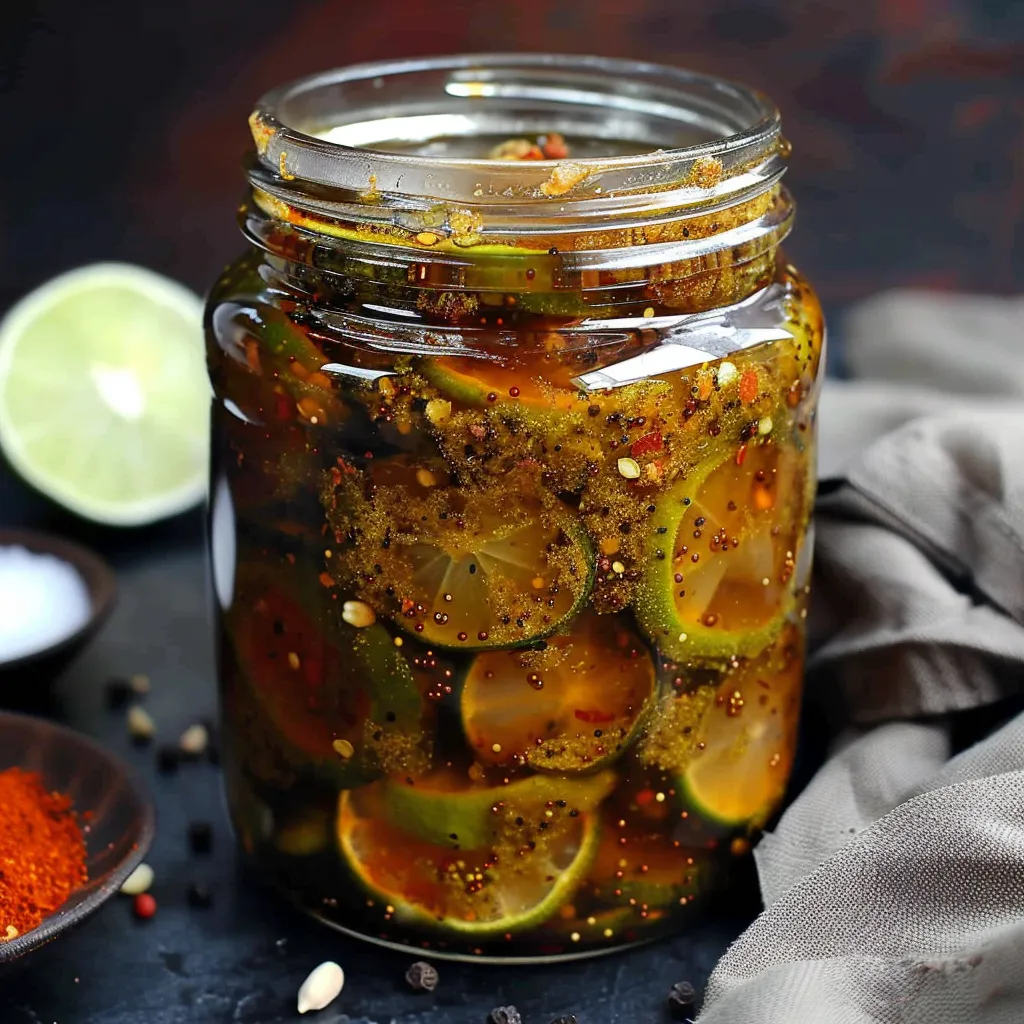 Pin it
Pin it
The moment you bite into food paired with homemade Indian lime pickle, your taste buds experience an explosion of complex flavors – tangy, spicy, and deeply aromatic all at once. This vibrant condiment transforms even the simplest plate of dal and rice into something extraordinary. What's even more remarkable is that this nimbu ka achaar isn't just bursting with flavor – it's alive with beneficial bacteria that nourish your gut with every bite. After years of buying store-bought versions, I discovered that making this traditional pickle at home not only produces incomparable taste but also preserves the probiotic benefits that commercial varieties sacrifice during pasteurization.
Last month, I served this pickle alongside a simple weeknight dinner of dal and rice. My neighbor, who had always claimed to dislike "strong Indian flavors," reluctantly tried a tiny bit mixed into her dal. Her eyes widened in surprise – by the end of the meal, she was asking for a jar to take home! It's that transformative quality that makes sharing this recipe so rewarding.
Essential Ingredients and Selection Tips
- Limes: Select organic, thin-skinned limes that yield slightly to gentle pressure. Smaller limes often have thinner skins and soften better during fermentation.
- Nigella Seeds (Kalonji): These small black seeds add a subtle oniony flavor. Do not substitute with black sesame seeds, which taste completely different.
- Fenugreek Seeds: These golden seeds add a maple-like sweetness with slightly bitter undertones. Store in a cool, dark place to prevent rancidity.
- Oil: Traditional recipes use mustard oil, but a mix of mustard oil and sunflower oil balances pungency and stability.
 Pin it
Pin it
I've learned that the quality of ingredients dramatically affects the final pickle. When I first started making this, I used conventional, thick-skinned limes and wondered why my grandmother's pickles were always more tender. Once I switched to thin-skinned organic varieties, the difference was immediately noticeable – the rinds softened beautifully during fermentation, making every bite perfectly tender.
Detailed Cooking Instructions
- Properly Sterilize Your Jar:
- Submerge a quart-sized mason jar and lid in boiling water for 10 minutes. Air dry completely without wiping to prevent contamination.
- Toast Seeds to Perfection:
- Toast nigella, fenugreek, and fennel seeds in a dry skillet over medium-low heat for 3-5 minutes until fragrant. Grind to a coarse powder.
- Prepare Limes with Care:
- Wash and completely dry limes. Quarter small limes or cut larger ones into ½-inch pieces. Place in a glass or ceramic bowl.
- Create the Spice Mixture:
- Mix ground spices, turmeric, salt, and chili powder with the lime pieces. Toss thoroughly to coat.
- Perfect the Tempering Process:
- Heat oil in a pan until shimmering. Add mustard seeds and let them pop for 20-30 seconds. Pour hot oil over the spiced limes.
- Mix Thoroughly and Transfer:
- Use a clean wooden spoon to mix well. Transfer to a sterilized jar, packing down slightly to eliminate air pockets.
- Harness the Power of Sunlight:
- Seal the jar and place it in direct sunlight for 5-7 days, bringing it indoors at night. Turn the jar daily to redistribute flavors.
My first batch of pickle taught me the importance of thorough drying. I rushed the process and left some moisture on the limes, resulting in a layer of white mold after a few days. Now I'm almost obsessive about ensuring everything is completely dry before starting. That simple change has given me perfect results every time since.
The Science of Fermentation
The magic of this pickle happens through lacto-fermentation, the same process behind sauerkraut and kimchi. The salt draws moisture from the limes, creating a brine where beneficial Lactobacillus bacteria thrive. These bacteria convert sugars into lactic acid, which preserves the pickle naturally while creating that distinctive tangy flavor. The sunlight accelerates this process by providing warmth for bacterial growth.
Regional Variations Worth Trying
While this recipe follows North Indian traditions, South Indian variations use sesame oil and curry leaves. Gujarati pickles often include jaggery for a sweet-spicy balance. Adding a handful of fresh curry leaves or a tablespoon of jaggery creates unique flavor profiles worth exploring.
Serving Beyond Traditional Meals
Traditionally served with dal and rice, this pickle enhances many unexpected dishes. Add a spoonful to grilled cheese sandwiches for a surprising flavor boost, mix into yogurt for a quick raita, or stir into salad dressings for depth and complexity.
Storage Wisdom
After fermentation, refrigerate the pickle to slow down the process. It reaches peak flavor after one month and lasts up to a year. Over time, the limes soften further, and the flavors deepen, developing umami-rich notes.
I learned these refinements through experimentation and conversations with elderly relatives who remembered the pickle-making traditions of their youth. Each small addition reflects a regional preference or family tradition, showing how diverse this seemingly simple condiment can be across Indian households.
Making this pickle connects me to generations of Indian women who performed this ritual each summer, harnessing the sun's energy to preserve food long before refrigeration existed. Every time I set my jar of brightly colored limes in the sunlight, I feel part of that unbroken tradition, creating not just a condiment but a living food that nourishes both body and spirit. The process has become a summer ritual in my home, marking the season as surely as the ripening of garden tomatoes or the first peaches at the farmers market.
 Pin it
Pin it
Frequently Asked Questions
- → How long does homemade lime pickle last?
- Properly fermented and stored lime pickle can last up to a year in the refrigerator. The high acid content of limes combined with salt and oil creates an environment that preserves the pickle naturally while allowing it to continue developing flavor.
- → Can I make this pickle without direct sunlight?
- Yes, though it may take longer to ferment. Place the jar in the warmest spot in your home (near a heater or on top of the refrigerator), and extend the fermentation time to 2-3 weeks, checking periodically for flavor development.
- → Is it normal for the pickle to bubble during fermentation?
- Yes, bubbling is a sign of active fermentation as beneficial bacteria convert sugars to lactic acid. This is completely normal and desirable. Just make sure to loosen the lid slightly each day to release any pressure buildup.
- → What can I substitute for asafetida (hing) in this recipe?
- While asafetida has a unique flavor, you can substitute a pinch of garlic powder and onion powder combined. Note that traditional asafetida adds a distinctive umami quality that these substitutes won't fully replicate.
- → Why are my limes turning bitter in the pickle?
- Bitterness usually comes from thick-skinned limes or leaving too much white pith. Choose thin-skinned limes and if necessary, remove some of the white pith before pickling. Some initial bitterness is normal and will mellow with time.
